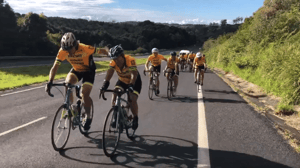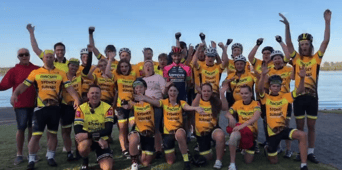The Forging of an Effective Team
“Coming together is a beginning, staying together is progress, and working together is success.” Henry Ford.
 A few years ago, I was asked by a friend to join him on a charity cycle ride from Sydney to Surfers Paradise. 1000km in 7 days. Naturally, I paused…I had never ridden a proper road bike, let alone owned one, and I am sure my son’s BMX would not cut the mustard!
A few years ago, I was asked by a friend to join him on a charity cycle ride from Sydney to Surfers Paradise. 1000km in 7 days. Naturally, I paused…I had never ridden a proper road bike, let alone owned one, and I am sure my son’s BMX would not cut the mustard!
“It will be one of the best things you have ever done” he offered as an incentive. Hey, I was up for a challenge. “When is it?” I asked.
“5 months’ time! Better get a bike and start training” came the reply.
My first training ride was about 12km resulting in dizziness and leg wobbles at the end. How was I going to ride around 135 km a day for 7 days? The scope of the challenge quickly dawned on me!
Five arduous months of training later, I fronted up with my borrowed bike, riding kit and plenty of nervous energy to join 150 riders and bikes plus support staff at the Hornsby TAFE car park.
As I was introduced to my 17 fellow pack riders, I found a mix of cycling veterans, newbies and everything in between. The pack captain led the pre-ride briefing of road rules, police escort points, breakdown protocol, morning tea and lunch break, single file on single lane roads and double up on freeway with the safety car. Pick a buddy. Don’t forget to drink.
Each pack was allotted a departure time, the whistle blew and off we went.
Shambolic! In the first 5km, our group suffered three punctures, chain detachments and, the need to make clothing adjustments. The incessant drizzle only increased our frustration.
After a while, we settled down. 55km to morning tea, another 45km to lunch and 35mk to the finish and beer.
The first day provided time to assess one another’s strengths, experience, ability, and relative motivation! Cliques and alliances formed, personalities were noted, weaknesses were identified. The mismatched riders in every pack were subsequently moved to other packs more suited to their experience. The day ended with extreme exhaustion and the fear of another 140km the next day.
Day 2. With aching legs, Ibuprofen, anti-chafing cream, and energy gels at the ready, we are told there will be some freeway riding and this will mean riding two-abreast and forming a peloton. When asked if this was our first time, many hands shot up, including mine. Apprehension. I had seen enough packs go down watching the Tour De France on the TV. Not a pretty sight.
We pull onto the freeway with safety pack car behind us. Quickly we double up and keep as close as possible to the rider in front. Packs riding this way can save up to 40% energy and maintain a speed that would be near impossible as a single rider.
This is where trust, communication, fear, vulnerability and concentration are crucial and quickly developed.
Suddenly, you are one of eighteen riders travelling two-abreast and twelve inches from the back wheel of the rider in front and knowing the same is behind you. With no visibility past the rider in front, you listen intently for warning calls about road debris and potholes. With your eyes glued to the wheel in front, you take care not hit it and bring you down and those behind you. You pray the riders in front are doing the same. Hands on brake at the ready. Calling out actions…slowing! stick! rock! hole! Possum!
At first, we are clumsy and uncoordinated. Too spread out. Deviating from the group line. People braking and slowing. The pack stretching out and bouncing back, slowing down. The poor folk at the back must have felt like they were tied to a virtual bungee rope.
After 20km of wordless concentration, we left the freeway and reverted to single file. Time to relax, chat, analyse and critique.
Our second 20km of freeway was much better. “Rolling!” Is called out. Outside riders move up two spots allowing the leading riders some relief. Two minutes later another “roll” and so on. Everybody gets time up the front. A shared load. The front two riders drag the pack along and take the headwind brunt.
Over the next five days, as our trust increased, so did our speed. With capability and faith in oneself and others growing, the confidence to take the front turn grew with it. When legs started to burn and energy waned, it became an unspoken acceptance to miss a front turn. The pack will carry the load. Without it, left to battle a 30km headwind would be near impossible.
Each passing day saw the kilometres melt away and the vibe and mood change. Even during single file riding, our relationships bonded the group, now performing as one unit with the common goal of reaching the finish line. The crashes, disagreements, torrential rain and howling wind were soon forgotten when the Surfers Paradise skyline came into view.
With blue and red lights flashing from Broadbeach to SeaWorld, our police escort applauded all 150 of us completing an experience that could never be forgotten!
And then it was over!
On Day 1 we were a collection of individuals, and by Day 7 we were a well-tuned team rolling into SeaWorld. We had become a cohesive entity, bonded through adversity, trust, vulnerability, empathy, mentoring, coaching, self-sacrifice, and personal achievement.

Patrick Lencioni wrote that the 5 key dysfunctions of a team are…
Absence of trust, Fear of Conflict, Lack of Commitment, Avoidance of team accountability and Inattention to team objectives.
We had overcome all theses and more. And seven more rides were certainly a testimony to that.
As my friend promised, this was one of the best things I had ever done!
But was only possible as a team!
The individual feat of riding a 1000km to Queensland was fantastic, but the experience of being immersed in the team to face that mental and physical journey was the true reward.
That was the best part.
Les Wingham; Chief Operating Officer

Related content:
.png?width=190&name=IPA%20Logo%20Transparent%20(Hi-Res).png)




